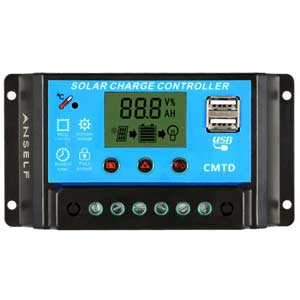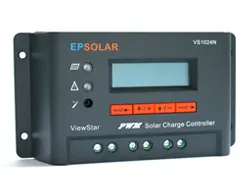
Battery Charge Controller
Charge Controllers For A Longer Battery Life
![]() For many people, building their own solar panel system and living off-grid is becoming a reality instead of a dream. Connecting the solar panels directly to a single battery or bank of batteries for charging may work, but is not a good idea. What’s needed is a battery charge controller to safely charge and discharge your deep cycle battery for a longer lifespan.
For many people, building their own solar panel system and living off-grid is becoming a reality instead of a dream. Connecting the solar panels directly to a single battery or bank of batteries for charging may work, but is not a good idea. What’s needed is a battery charge controller to safely charge and discharge your deep cycle battery for a longer lifespan.
A standard 12 volt solar panel which can be used to recharge a battery, could actually be putting out nearly 20 volts at full sun, much more voltage than the battery needs. This difference in voltage between the required 12 volts need for the battery and actual 20 volts being generated by the solar panel translates into a greater current flow into the battery.
This results in too much unregulated solar generated current overcharging the battery which could cause the electrolyte solution within the batteries to overheat and evaporate off, resulting in a much shortened battery life and ultimately, complete battery failure.
Then the quality of the charging current will directly affect the life of any connected deep cycle battery, so it is extremely important to protect batteries of a solar charging system from being overcharged, or even undercharged, and we can do just that using a battery charge regulation device called a Battery Charge Controller.

A battery charge controller, also known as a battery voltage regulator, is an electronic device used in off-grid systems and grid-tie systems with battery backup. The charge controller regulates the constantly changing output voltage and current from a solar panel due the angle of the sun and matches it too the needs of the batteries being charged.
The charge controller does this by controlling the flow of electrical power from the charging source to the battery at a relatively constant and controlled value.
Thus maintaining the battery at its highest possible state of charge while protecting it from being overcharged by the source and from becoming over-discharged by the connected load. Since batteries like a steady charge within a relatively narrow range, the fluctuations in output voltage and current must be tightly controlled.
Solar Battery Charge Controller
Then the most important functions of battery charge controllers used in an alternative energy system are:
- Prevents Battery Over-charging: This is too limit the energy supplied to the battery by the charging device when the battery becomes fully charged.
- Prevents Battery Over-discharging: Automatically disconnect the battery from its electrical loads when the battery reaches a low state of charge.
- Provides Load Control Functions: Automatically connect and disconnect the electrical load at a specified time, for example operating a lighting load from sunset to sunrise.
Solar panels produce direct or DC current, meaning the solar electricity generated by the photovoltaic panels flows in only one direction only. So in order to charge a battery, a solar panel must be at a higher voltage than the battery being charged. In other words, the voltage of the panel must be greater than the opposing voltage of the battery under charge, in order to produce a positive current flow into the battery.
When using alternative energy sources such as solar panels, wind turbines and even hydro generators, you will get fluctuations in output power. A charge controller is normally placed between the charging device and the battery bank and monitors the incoming voltage from these charging devices regulating the amount of DC electricity flowing from the power source to the batteries, a DC motor, or a DC pump.
The charge controller turns-off the circuit current when the batteries are fully charged and their terminal voltage is above a certain value, usually about 14.2 Volts for a 12 volt battery. This protects the batteries from damage because it doesn’t allow them to become over-charged which would lower the life of expensive batteries. To ensure proper charging of the battery, the regulator maintains knowledge of the state of charge (SoC) of the battery. This state of charge is estimated based on the actual voltage of the battery.
During periods of below average insolation and/or during periods of excessive electrical load usage, the energy produced by the photovoltaic panel may not be sufficient enough to keep the battery fully recharged.
When the batteries terminal voltage starts to drop below a certain value, usually about 11.5 Volts, the controller closes the circuit to allow current from the charging device to recharge the battery bank again.
In most cases a charge controller is an essential requirement in any stand-alone PV system and should be sized according to the voltages and currents expected during normal operation. Understanding your batteries and their charging requirements is also a must for any battery based solar system.
Any battery charge controller must be compatible with both the voltage of the battery bank and the rated amperage of the charging device system. But it must also be sized to handle expected peak or surge conditions from the generating source or required by the electrical loads that may be connected to the controller.
There are some very sophisticated charge controllers available today. Advanced charge controllers use pulse-width modulation, or PWM. Pulse width modulation is a process that ensures efficient charging and long battery life. However, the more advanced and expensive controllers use maximum power point tracking, or MPPT.
Maximum power point tracking maximizes the charging amps into the battery by lowering the output voltage allowing them to easily adapt to different battery and solar panel combinations such as 24v, 36v, 48v, etc. These controllers use DC-DC converters to match the voltage and use digital circuitry to measure actual parameters many times a second to adjust the output current accordingly. Most MPPT solar panel controllers come with digital displays and built-in computer interfaces for better monitoring and control.
Choosing the Right Solar Charge Controller

We have seen that the primary function of a Battery Charge Controller is to regulate the power passing from the generating device, be it a solar panel or wind turbine to the batteries. They assist in properly maintaining the solar power system batteries by preventing them from being overcharged or undercharged, thus offering long life to batteries.
The solar current being regulated by a battery charge controller not only charges batteries but can also be passed to inverters for converting the direct DC current to alternating AC current to supply the utility grid.
For many people who want to live “off grid”, a charge controller is a valuable piece of equipment as part of a solar panel or wind turbine power system. You will find numerous charge controllers manufactures online, but choosing the right one can sometimes be quite confusing and to add to your worries they are not cheap either, so finding a good quality solar charge regulator really matters.
It’s best not to go for those low quality cheaper ones, as they may actually harm the battery life and increase your overall expense in the long run. For a little peace of mind then why not Click Here and check out some of the better battery charge controllers available from Amazon and learn more about the different types of solar charge controllers available as part of your solar power system helping you to save money and the environment.





![EPEVER MPPT Solar Charge Controller 40A 150V PV Solar Panel Controller Negative Ground W/ MT50 Remote Meter + Temperature Sensor PC Monitoring Cable[Tracer4215BN]](https://m.media-amazon.com/images/I/41Piu7aIW4L.jpg)





Please Speak up!
We hope this Battery Charge Contr